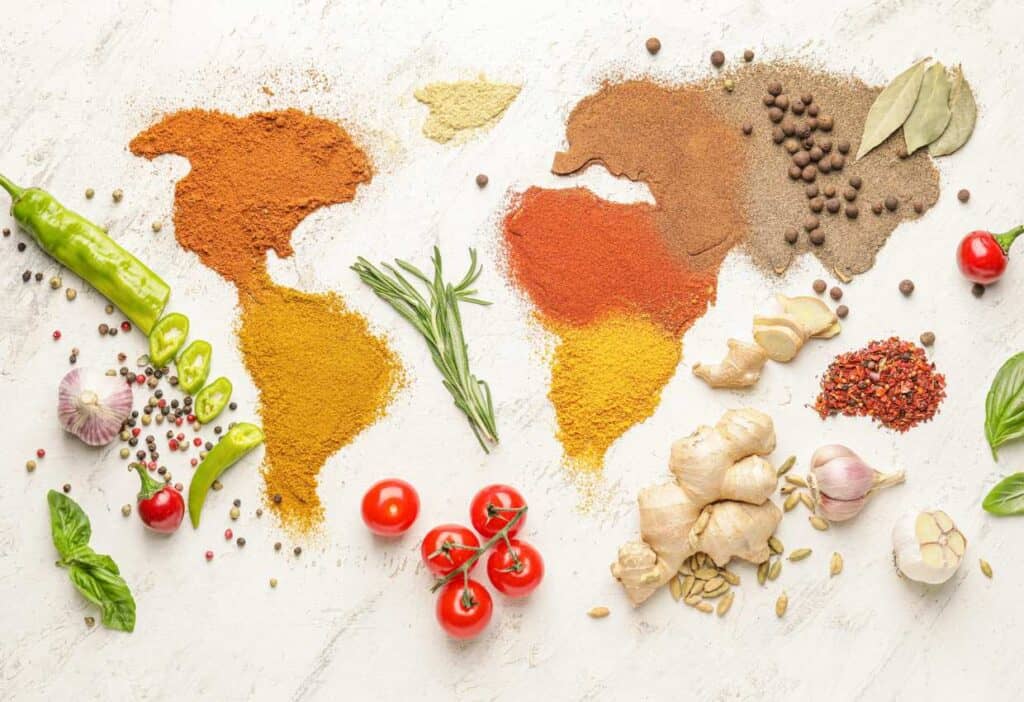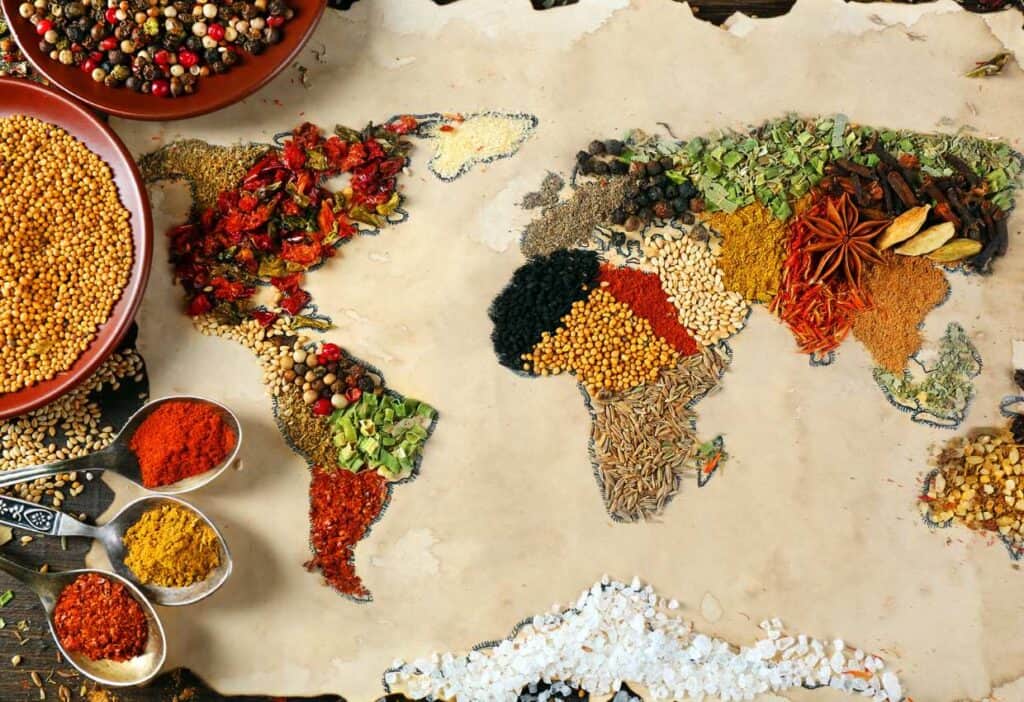Cuisines are distinctive styles of cooking practices and traditions, often associated with a specific culture or geographic region. There are different types of cuisines, each with ingredients, techniques and dishes unique to its culture, conveying a sense of identity and history.

National cuisines are often the product of centuries of tradition and the interplay of natural resources, historical migrations and trade relations. These factors gave rise to diverse flavors and food presentations worldwide.
The concept of cuisine is deeply rooted in the culture of a society. It is a powerful expression of its heritage. Cultural influences shape how food is prepared and served, and communal values and historical circumstances are reflected in the dining habits and ingredients used. From the spices in Indian cuisine to the minimalist approach of Japanese dishes, each cuisine offers a unique glimpse into the lifestyles and societal structures that have shaped it.
Exploring different types of cuisines not only broadens one’s culinary repertoire but also enhances understanding and appreciation of the diverse cultures that inhabit our planet. It is a journey through the senses that can bridge gaps between people, as food is a universal language that transcends linguistic and cultural barriers, fostering connections and shared experiences. By exploring global cuisines, individuals can discover the richness and diversity that the world’s various cultures offer.
“I’m partial to middle eastern cuisine. Even though my heritage is Eastern European, I grew up in Israel and I just love the variety of flavors, textures, fresh herbs and vegetables of Middle Eastern cuisine. It’s what makes me feel the warmest inside!”
— Ksenia Prints, At the Immigrant’s Table
Historical and cultural influences on cuisines
Centuries of historical events and cultural practices deeply influence today’s foods. Climate, trade, local ingredients and traditions have all played a role in shaping regional gastronomy.
Evolution of regional cuisines
Regional cuisines have developed through a complex interplay of local climate and available resources. The Mediterranean, for instance, has an environment conducive to growing olive trees. As a result, olive oil has become a staple in Southern European diets. In contrast, colder regions like Scandinavia have traditionally relied more on meat and dairy products due to their longer preservation times in colder climates. Each region utilizes unique ingredients, from rice in Asia to wheat-based bread and pasta in Europe, forming distinct culinary identities that reflect their environment and historical practices.
Cuisine and cultural exchange
Cultural exchange has been pivotal in shaping the world’s cuisines. For example, the New World’s introduction of tomatoes to Italy transformed Italian cuisine, now famed for its tomato-based pasta sauces and pizzas. The spices brought to Europe through trade with Asia and the Middle East infused local dishes with new flavors, shaping not just European cuisine but also its cultural fabric. Celebratory dishes and daily meals adapted to include these new and exotic ingredients demonstrate how cultural exchange can profoundly impact food traditions.
Influence of trade on gastronomy
Trade throughout history has been a driving force in the evolution of international cuisines. The spice trade routes dramatically increased the variety of spices available in different regions, with coveted items like pepper and cinnamon becoming common in European and Asian dishes. Moreover, the trade of grains such as wheat and rice helped spread staple foods around the world. The availability of wine, cheese and other local specialties expanded beyond their regions of origin, indicating the broadening tastes and the desire for diverse food experiences globally.

Major regional cuisines
Global food diversity showcases the unique flavors, ingredients and cooking techniques that define cultures worldwide. Each region’s food culture offers a distinct culinary experience shaped by its history and traditions.
Asian cuisine
Asian cuisine encompasses a vast array of culinary traditions and flavors, each region bringing its own unique ingredients and cooking techniques to the table.
Chinese cuisine emphasizes fresh ingredients and balanced flavors, with each region offering unique dishes. Guangdong or Cantonese cuisine, for instance, is renowned for its variety of soups and minimal use of sauce to preserve the food’s authentic taste. Notable dishes include dim sum and Peking duck.
Filipino cuisine presents a hearty and flavorful mix known for its eclectic blend of Spanish, American and Asian influences. Signature dishes such as adobo, meat marinated in vinegar, soy sauce and garlic, and “sinigang”, a sour soup, exemplify its rich culinary diversity.
Indian cuisine is distinguished by its rich use of spices and diverse regional dishes. Celebrated for ingredients like cumin, coriander and turmeric, it offers a wide array of vegetarian dishes in line with the country’s cultural and religious practices. Butter chicken and chana masala are among its key dishes.
“I love Indian cuisine! I might be biased because I grew up in India but many people often don’t realize that there are so many sub cuisines within the country that are wildly different! The aromatic spices, variance in textures, and the use of fresh, seasonal ingredients are some of the reasons why I love Indian cuisine.”
— Shruthi Baskaran-Makanju, Urban Farmie
European cuisine
European cuisines blend rich historical traditions with diverse ingredients, offering a vast array of flavors and cooking styles.
Italian cuisine, celebrated globally, is typified by pasta,
French cuisine is renowned for its finesse, featuring pastries like croissants and luxury ingredients such as truffles and foie gras. The concept of “terroir” — how a region’s climate, soils and aspects affect the taste of food — plays a critical role in its culinary tradition. Signature dishes such as coq au vin and the staple baguette reflect the rich culinary history and the importance of both sophisticated and everyday foods in French culture.
Greek and Spanish cuisines offer a Mediterranean fare rich in olive oil, fresh vegetables and seafood. Both cuisines celebrate the joy of sharing meals, with tapas in Spain and mezze in Greece, encouraging communal dining experiences. Spain’s paella and tapas, along with Greece’s moussaka and feta cheese, showcase their dedication to flavorful communal dining, emphasizing the social nature of Mediterranean meals.
African and Middle Eastern cuisine
African and Middle Eastern cuisines weave together the traditions and complex flavors of two vibrant culinary worlds.
African cuisine reflects a rich tapestry of cultures, with dishes like Ethiopian injera and jollof rice offering a flavorsome experience. The cuisine is known for its inventive use of grains, beans and vegetables, adapted to diverse climates and landscapes across the continent.
Middle Eastern cuisine is recognized for dishes like falafel, hummus, baklava and kebabs, as well as the use of ingredients like dates and sesame seeds. This cuisine emphasizes a balance of flavors and textures, often featuring a mix of sweet and savory elements in a single dish.
Central and South American cuisine
Central and South American cuisine reflects a rich blend of Indigenous, European, African and Asian influences, creating a diverse culinary landscape that is both flavorful and full of depth.
Central American cuisine is filled with staples such as corn, beans and various tropical fruits, which form the foundation of its vibrant and flavorful dishes. In Costa Rica, dishes like “gallo pinto”, a mixture of rice and beans, and “casado”, another rice dish with beans, plantains and protein, showcase the nation’s ability to blend these local flavors into every meal.
South American cuisine is built upon staples like potatoes, quinoa, yuca and a variety of meats, leading to a wide array of dishes that are palate-engaging. Colombia’s culinary offerings, such as arepas and “andeja paisa”, a meat platter, emphasize the country’s rich culinary heritage. Meanwhile, Peru makes a significant contribution with dishes like ceviche and the stirfry, “lomo saltado”, which showcase the innovative use of fresh ingredients and spices.

Contemporary trends in global cuisines
The culinary world is ever-evolving, with the recent trend spotlighting the amalgamation of various cultural flavors and a growing preference for health-conscious alternatives. This shift has led to the innovation of dishes that not only tantalize the palate but also cater to nutritional needs, marking a new era in global cuisine.
Fusion and hybrid cuisines
Fusion cuisine has created a revolutionary blend of global flavors. For instance, Thai and Vietnamese elements combine with traditional Mexican ingredients, resulting in innovative dishes like Thai-Mexican burritos, using spices and herbs unique to both cultures. Similarly, Korean and German culinary traditions combine kimchi-infused flavors with hearty German sausages, crafting a palate-pleasing kimchi bratwurst.
Rise of vegetarian and plant-based options
Italian and Lebanese cuisines are transcending meat-heavy traditions by integrating plant-based ingredients. Pizzas are being reinvented with rich vegan cheeses and robust vegetable toppings. Lebanese staples, renowned for their veg-friendly options, are becoming more prevalent, with dishes like falafel and tabbouleh gaining prominence. Moroccan, Turkish and Caribbean cuisines are also seeing a surge in vegetarian meals as they introduce innovative uses of legumes and grains to the delight of health-conscious consumers.
Kristen Wood is a photographer, writer, world traveler, and the creative force behind MOON and spoon and yum and Foodventures Abroad. She is also the author of Vegetarian Family Cookbook, Fermented Hot Sauce Cookbook, and Hot Sauce Cookbook for Beginners. Her work has been featured in various online and print publications, including Elle, Martha Stewart, Yoga Journal and more.